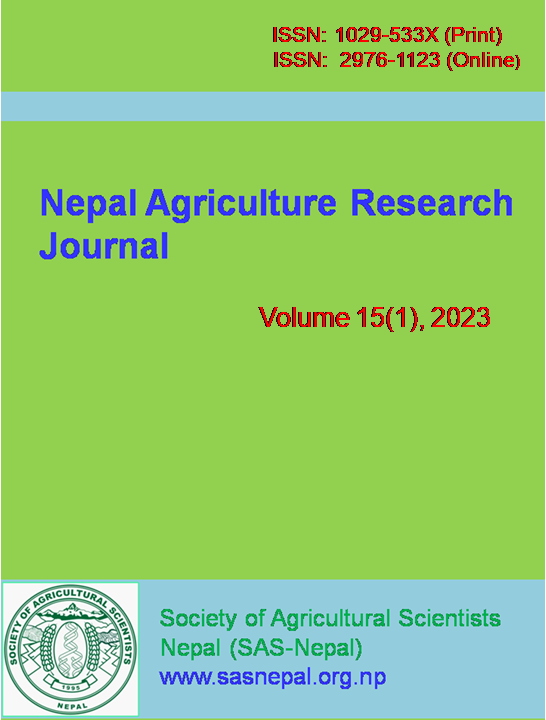Integrated management of late blight of potato in Pokhara, Kaski, Nepal
DOI:
https://doi.org/10.3126/narj.v15i1.51508Keywords:
AUDPC, Genotypes, date of planting, Integrated management, Late blightAbstract
A field experiments was carried out in Pokhara, Kaski, Nepal, to identify integrated disease management options against late blight of potato under natural epiphytotic conditions.Twelve genotypes of potato, including Janakdev as resistant and Cardinal as susceptible, were evaluated in a randomized complete block design with three replications. Similarly, a two-factor randomized complete block design experiment with three replications was carried out to investigate the interaction effect of planting date and application of chemical, botanical extracts, and a biocontrol agent.Susceptible variety Cardinal was planted in three different dates starting from October 11 at a 15-day interval and received five sprays each of the chemical fungicide Krilaxyl Gold (mancozeb 64% + metalaxyl 8%), 10% V/V extracts of garlic (Allium sativum), neem (Azadirachta indica), and bakaino (Melia azedarach), and Phytoderma (Trichoderma viride) 109 CFU/mL) and water spray as an untreated control.Among the genotypes, CIP384321.15 and Khumal Ujjwal showed the significantly (p<0.01) the lowest mean value of AUDPC (the area under the disease progress curve), whereas susceptible check Cardinal and Khumal Laxmi showed the significantly (p<0.01) the highest mean AUDPC values. Similarly, the 11 October planting with the application of Krilaxyl Gold showed the lowest total AUDPC value (382.65) and the highest total AUDPC value (1533.41). Besides the chemical fungicide, the application of extracts of garlic, bakaino, neem, and phytoderma could significantly reduce the disease and increase tuber yield. These botanical extracts and biocontrol agents can be used in the integrated disease management of potato late blight.
Downloads
Downloads
Published
How to Cite
Issue
Section
License
Copyright (c) 2023 Adhikari et al.

This work is licensed under a Creative Commons Attribution-NonCommercial-NoDerivatives 4.0 International License.
This license allows reusers to copy and distribute the material in any medium or format in unadapted form only, for noncommercial purposes only, and only so long as attribution is given to the creator.




